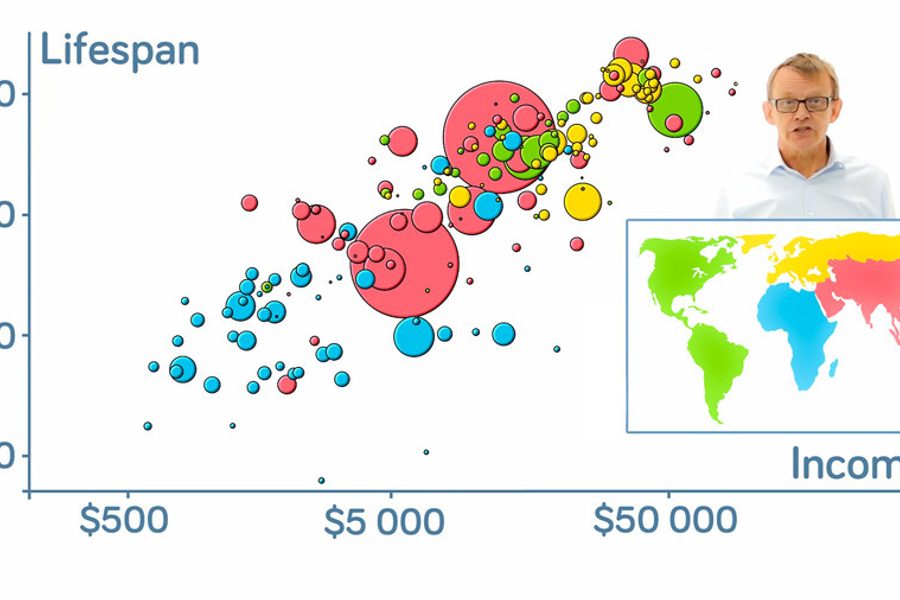Why You Shouldn’t Listen to Self-Serving Optimists Like Hans Rosling and Steven Pinker
There’s a reason Bill Gates loves Pinker and Rosling—their analyses obscure inequality.
Roland Paulsen

In 2017, Bill Gates tweeted that Steven Pinker’s The Better Angels of Our Nature: Why Violence Has Declined was “the most inspiring book I’ve ever read.” It became the top-selling book on Amazon.
In 2018, Gates went a step further, offering electronic copies of the late TED Talk star Hans Rosling’s book, Factfulness: Ten Reasons We’re Wrong About the World — And Why Things Are Better Than You Think, to all U.S. college graduates for free. That prompted Peter Wallenberg Jr., scion of Sweden’s richest family, to offer the book as a free downloadable file to all Swedish high school students as well.
Pinker and Rosling, the stars of the glass-halffull school of intellectuals known as the New Optimists, seek to persuade people that civilization is heading in the right direction, with the world getting better every day. This affirmational declaration is one of the global elite’s rituals of “neoliberal self-congratulation,” as editor-in-chief of The Baffler, Chris Lehmann, puts it. While not saying that all is well, New Optimists fixate on positive trajectories and scold critics for being “alarmists.” Social progress is not a matter of struggling for justice, the “optimistic” narrative goes, but rather extending the benefits of economic growth, a task best supervised by philanthropic capitalists (like, say, Gates), who, of course, are the biggest beneficiaries of such “progress.”
The New Optimists have successfully marketed this worldview as “neutral” and “fact-based,” to use two of Rosling’s favorite words. Some of these pundits, like Pinker in his most recent book, Enlightenment Now, aggressively argue that “none of us are as happy as we ought to be, given how amazing our world has become,” and bemoan the fact that people seem to “whine, carp and kvetch as much as ever.”
The “facts” these New Optimists offer, however, show that their progress narratives rest on shaky assumptions, cherry-picked data and a faulty moral compass. When it comes to measuring “progress,” these optimists confuse what was, in centuries past, with what could have been, in the late 20th and 21st.
In his native Sweden, Rosling is for the most part considered a harmless “edutainer” (his word). He has, however, drawn the ire of environmentalists. In his 2018 book, Factfulness, he depicts climate activists as alarmists and the estimates of environmental damage as inflated. He recalls a 2009 conversation in which Al Gore asked him to present numbers on climate change that Rosling regarded as exaggerated. Allegedly, Gore insisted, “We need to create fear.” Rosling nobly refused, proving that fact-based researchers like himself are concerned with truth and thus have a less extremist view of the world.
But Rosling only acknowledges those truths that are convenient to his optimistic theory of progress. Though far from a climate change denier, Rosling frequently cherry-picks the more hopeful predictions about the environment, trumpeting the happy news that endangered tigers, giant pandas and black rhinos have increased in numbers over the past 20 years. Meanwhile, he neglects the severity of our actual peril: the rapid acceleration of human-induced species loss that has become known as “the sixth mass extinction” (the fifth occurred some 65 million years ago).
There are also more subtle problems with Rosling’s “factfulness.” As a physician, Rosling is best known for his dynamic World Health Chart, “a world map for health and wealth” that depicts all nations as bubbles varying in size based on population. In his famous edutainment sequence, the bubbles float upward over time toward ever-increasing income and life expectancy. “With aid to trade, green technology and peace,” he says, it is fully possible that everyone will eventually make it to the “healthy, wealthy corner.”
There are several problems with this type of chart. As anthropologist Jason Hickel recently remarked, the data on poverty has only been collected since 1981. Numbers going back to 1800, as Rosling’s bubble chart does, are extremely uncertain — not to mention meaningless on another level. Why track social progress starting from the peak of colonialism? Much of the world had just suffered several centuries of European exploitation and enslavement. What happened since pre-colonialism was a process of proletarianization where most of humanity went from having little need for money — and directly enjoying what the land and water had to offer — to being forced into wage labor and learning to get by on a few dollars a day. Since the GDP calculations, on which Rosling’s numbers are based, tend to underestimate the value of noncommodified activities, Rosling’s chart hides how people have been stripped of the commons on which they traditionally depended. Yet Rosling, like other New Optimists, ignores the history of colonialism and commodification when presenting the income numbers, making it all the easier to celebrate them as proof of progress.
Ironically, Rosling’s bubbles also use per-capita averages, for both income and life expectancy, in a way that Rosling himself criticizes in Factfulness. In his words, “Averages mislead by hiding a spread (a range of different numbers) in a single number.” The spread his chart hides is the disparities of wealth and health within nations, inequalities he consistently chooses to play down.
This might sound trivial, but if we look at the United States, for instance, the increase in percapita income reflects a reality that far from all Americans have experienced. For the poorer half of the population, the average annual income has stagnated at about $16,000 per adult since 1980.
During the same time, the average income of the top 1% has tripled from $420,000 to $1.3 million. Since the income share of the 1% is almost twice as large as that of the bottom 50 percent, when the rich become richer, the national average rises.
Of course, inequalities like these affect how long people live. According to a study in Clinical Review & Education, an American man in the top 1% has an average life expectancy of 87 years, whereas a man in the bottom one percent has 73 years.
This income spread, which reflects healthcare access and stress levels, is not unique to the United States. In relatively egalitarian Sweden, similar inequalities can be found. The average life expectancy of the less educated inhabitants of a southern suburb of Stockholm, Vårby Gård, is 18 years less than that of the highly educated inhabitants of a northern suburb, Danderyd. Rosling must have known about these inequalities; they were widely discussed in Swedish newspapers and the numbers came from the Karolinska Institute, the university where Rosling once worked as a professor. Rosling relies so much on what sociologist Saskia Sassen has called “methodological nationalism” — the tendency to examine issues from the perspective of the nation-state — that he fails to acknowledge the large groups within nations who are left behind in the race to the “healthy, wealthy corner.”
Apart from these methodological flaws, it is baffling that Rosling presents his bubble chart as a map of “world health,” given that it is actually a map of income and life expectancy. Not even life expectancy can be counted as a good measure of health, given that one’s life may be spent in poor health. In a study measuring healthy life expectancy in 195 countries and territories, researchers found that, while life expectancy increased globally by 7.4 years between 1990 and 2017, the years of life gained in Bahrain were spent entirely in poor health. Though Rosling mentions physical illnesses in Factfulness, he discusses only those that are in decline, such as measles and diarrhea. In other words, Rosling’s definition of “health” is far from comprehensive.
Most strikingly, Rosling must have worked hard to ignore the data on mental health, given that the global leading cause of ill health today is depression. According to new estimates by Sarah Flèche and Richard Layard of the London School of Economics, mental disorders explain even more misery than poverty and physical ill health, as reflected in life satisfaction surveys.
If mental health sounds like a less than life-and-death issue, bear in mind that life expectancy in Britain and the United States has stagnated over the past few years. In the United States, this is clearly related to so-called deaths of despair: deaths due to suicide, alcohol and drug overdoses, which, according to the Centers for Disease Control and Prevention, have rapidly increased for at least 15 years. In fact, the New York Times reported in 2018 that drug overdose deaths actually caused life expectancy to drop over the previous three years, “a pattern unprecedented since World War II.”
To see the global distribution of mental health, look at the Global Burden of Disease Study, a data set funded by the Bill & Melinda Gates Foundation, which is referred to in Factfulness but not with respect to mental health. This study has been promoted as having the most reliable statistics on how the burden of disease is distributed among nations. Type in “depression” or “anxiety,” and the Americas, Europe and Australia light up on the world map. If you add “eating disorders,” “bipolar disorder,” “drug use disorder,” “alcohol use disorder” and “schizophrenia” and then distribute the combined burden of disease according to national income level, you will notice how high-income economies keep lighting up the map, as also revealed in the World Health Organization’s (WHO) World Mental Health Surveys. (Most of this data has been gathered using diagnostic face-to-face interviews with hundreds of thousands of adults from representative household samples, minimizing the cultural impact on the data of, for example, disproportional rates of psychiatric diagnosis in richer nations.)
So widespread is this type of suffering that, in 2017, the WHO mounted a one-year global campaign to raise awareness of depression. Rosling chooses to ignore facts like these that strike a discordant note with the New Optimist notion that economic growth is a panacea. Except for their disproportionate emission of greenhouse gasses, high-income economies are, to Rosling’s mind, leading the world toward ever greater prosperity — which may explain why philanthrocapitalists like him so much: He reassures people like Gates that, since things are always improving, we need not bother to change how the world operates (giving capitalists justification to maintain the status quo). “Look for systems, not heroes,” Rosling writes. When something good happens, “give the system some credit.”
But it’s unclear exactly what “system” Rosling has in mind.
Even if we recognize that life has improved in many respects, measuring social progress by Rosling’s metrics quickly becomes problematic. In dictatorships such as Qatar, Singapore and Kuwait, average income and lifespan also have progressed, outshining several Western democracies, if not all, as is the case in Singapore. In China, life expectancy grew spectacularly fast between 1949 and 1976 — probably the fastest growth in life expectancy ever registered — which more than doubled Chinese life expectancy in less than 30 years. And yet, during this growth period, China was governed by Mao Zedong, one of the worst dictators in history.
Do these political and economic systems deserve credit? Maybe income, life expectancy and even health statistics are poor indicators of whether we are living in the best possible way. Maybe we shouldn’t only look at a society as it is, but also consider its potential — what it could have been.
Rosling doesn’t make a single note in Factfulness on potentiality and our increasing capacity to end poverty. To exclusively discuss social progress based on a certain set of facts removes moral values from the debate. Facts only point to that which is and has been, but when we argue about values such as freedom or justice, we are considering the less measurable, counterfactual world of what might have been or what might be. This is precisely the world that the New Optimists refuse to acknowledge.
For example, when Rosling says that the death of 4.2 million babies in 2017 is a “beautifully small” number, he does so to point out that the annual number of child mortalities has fallen markedly since 1950. But it takes a certain kind of cold amorality to call 4.2 million infant deaths “beautifully small.” Like other New Optimists, his argument is that we should continue doing more of what has proved to work so far (economic growth) and celebrate the improvements that have been made. But this argument neglects to take into account other avenues that we have not pursued and that could have led to a steeper decline in child mortality.
A recent UNICEF press release, for instance, notes that the global child mortality rate has declined since 1990, and adds that “without urgent action, 56 million children under five will die from now until 2030.” Following the ruthless rationale of Rosling, the annual death toll will likely become all the more “beautiful” during this time provided that the decline continues, no matter how slow. But this fails to acknowledge the present-day potential for eradicating child mortality caused by poverty. It is not a scientific problem that 1 in 13 children in sub-Saharan Africa die before their fifth birthday while that same statistic in high-income countries is 1 in 185. It is a social problem and, as UNICEF notes, a problem of economic inequality.
Oxfam reported in January that a 0.5 percent tax on the wealth of the world’s richest 1% would raise more money than it would cost to educate the world’s 262 million children currently out of school and provide healthcare that would save the lives of 3.3 million people. Instead, according to the British House of Commons Library, we are on a course that will concentrate two-thirds of the world’s wealth in the richest 1% by 2030.
Facts like these do not fit into the “optimistic ” TED Talk celebration of neoliberalism — the docile, yet enthusiastically marketed, resignation to business as usual. On the contrary, they point to potentialities that remain unrealized due to the exploitative relationships on which global capitalism relies. As Yale philosopher Thomas Pogge suggests, it is more morally conscientious to compare existing poverty “not with historical benchmarks but with present possibilities: How much of this poverty is really unavoidable today? By this standard, our generation is doing worse than any in human history.”
To regard as “beautiful” the fact that children still die because they lack cheap medicine, vaccines and clean water is to ignore our enormous growth in global labor productivity and total affluence, as well as our potential to eliminate inequality. To block out simple considerations like this does not sound like “factfulness” to me. It does, however, sound like a precondition for getting free promotion from Bill Gates.





